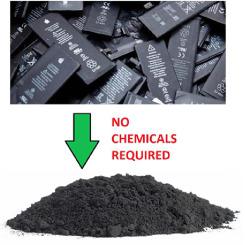Journal of Energy Storage ( IF 8.9 ) Pub Date : 2020-06-18 , DOI: 10.1016/j.est.2020.101564 Milad Jafari , Mohammad Mahdi Torabian , Alireza Bazargan

|
The high cost of primary materials and their limited resources, as well as the ever-increasing amount of waste, has magnified the need for recycling and resource recovery from lithium ion batteries (LIB). This need will only be exasperated in the future as personal electronic equipment and electric vehicles (EV) become more widespread. In this study, a simple process for the separation of the cathode materials from waste Apple iPhone 6 lithium batteries is proposed, consisting of thermal treatment followed by ultrasonication. The main advantages of the process are its simplicity and complete independence from all chemicals. Heating the cathode material to 550°C gradually increases the removal efficiency; however, further increase in temperature results in a sharp decline of removal due to changes in the Al foil structure. With limited aeration inside the muffle furnace the removal barely exceeded 60%, whereas under suitable aeration, removal efficiencies exceeding 90% were obtained. Ultrasonication aids the release of cathode powder by creating convective flow as well as intense cavitation. As ultrasonication time and power increase, so does the removal efficiency. However, by increasing the power from 50 W to 100 W, the cathode powder separation efficiency decreases. This is because the numerous cavitation bubbles create a barrier for the transmission of acoustic energy to other parts of the tank, meaning the physical vibration of the transducer is greater than the fluid's ability to stay in contact. The final obtained cathodic powder under optimum conditions (heating for 15 min at 550°C, followed by ultrasonic treatment at 45°C and 50 Watts for 1 min) was 45.5% Co, 4.9% Al, 13.7% Cu, 3.6% Li, and 13.7% Ni.
中文翻译:

锂离子电池资源回收的简便,无化学方法的阴极粉末分离方法
主要材料的高成本及其有限的资源,以及不断增加的废物量,使得对锂离子电池(LIB)进行回收和资源回收的需求日益扩大。随着个人电子设备和电动汽车(EV)的普及,这种需求只会在将来激怒。在这项研究中,提出了一种从废苹果iPhone 6锂电池中分离正极材料的简单方法,该方法包括热处理,然后进行超声处理。该方法的主要优点是其简单性和与所有化学品的完全独立性。将阴极材料加热到550°C逐渐提高去除效率。然而,由于铝箔结构的变化,温度的进一步升高导致去除率急剧下降。在马弗炉内有限的通气条件下,去除率几乎不超过60%,而在适当的通气条件下,去除率可超过90%。超声波通过产生对流以及强烈的空化作用来帮助释放阴极粉末。随着超声时间和功率的增加,去除效率也随之增加。然而,通过将功率从50W增加到100W,阴极粉末分离效率降低。这是因为大量的空化气泡为将声能传输到储罐的其他部分创建了障碍,这意味着换能器的物理振动大于流体保持接触的能力。在最佳条件下(在550°C加热15分钟,然后在45°C和50瓦超声处理1分钟)最终获得的阴极粉末为45。









































 京公网安备 11010802027423号
京公网安备 11010802027423号